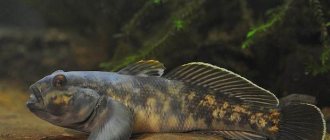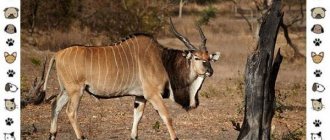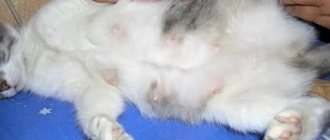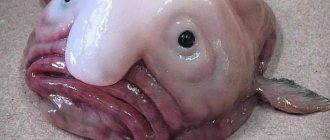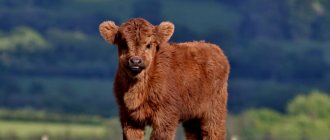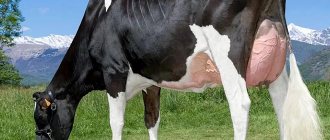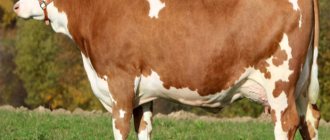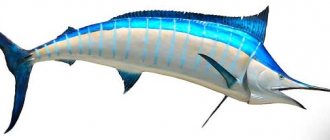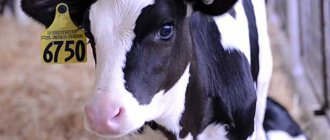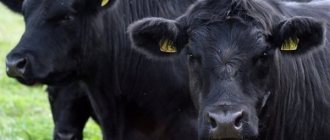Gobies are one of the most common fish living in the Azov and Black Seas, as well as in some rivers that flow into them. Any fisherman who came to these bodies of water at least once was sure to fish for them. Local residents have put this fishing on an industrial basis, but this does not harm the population of these fish in any way.
Adapted to almost any conditions, gobies feel great in their habitat, and their catching is always effective. Fish has meat with excellent taste, and from a culinary point of view it is almost universal - it can be boiled, fried, salted and dried. Dried fish are very popular. Despite its relative simplicity, catching gobies is a very interesting activity.
Description
goby
The round goby belongs to the Bychkov family, which is represented by more than 20 species in the coastal zone of the Azov and Black Seas, in estuaries, river mouths and the rivers themselves. Length up to 25 cm, weight up to 250 grams. The body is stocky, the tail is flattened towards the end, completely covered with scales, which also extend to the back of the head. It has a ridged head typical for gobies, a brownish-gray body with variations in tones, on the sides of which there are several dark brown elongated spots. It differs from other gobies by the presence of a black oval spot on the first dorsal fin.
The system of canals and pores of the lateral line is well developed, especially on the head. The mouth is of moderate length, its corners do not extend beyond the eyes. The coloring is varied, from light gray with subtle spots on the sides, to brown with a clear pattern or black (the latter is especially common during the spawning period, the males guarding the eggs remain black), however, there is a characteristic species-specific feature of this goby - a clear black spot, sometimes surrounded yellowish border on the back of the first dorsal fin. The head is usually darker than the body, the fins are gray.
External links [edit]
| Wikimedia Commons has media related to Neogobius melanostomus . |
- Round goby, an invasive species in the Great Lakes
- Aquatic Invasive Species - Minnesota Sea Grant
- Global Invasive Species Database
- Harmful water hitchhikers
- Minnesota DNR
- InvadingSpecies.com, Ontario Ministry of Natural Resources and Ontario Anglers and Hunters Federation
- USGS Non-native species
- Species Profile - Round Goby (Neogobius melanostomus), National Invasive Species Information Center, US National Agricultural Library. Lists general information and resources on Round Goby.
- University of Michigan Museum of Zoology. Animal Diversity Network. Neogobius melanostomus. Uploaded May 18, 2009
- GLANSIS Species Fact Sheet, USGS
| Taxon identifiers |
|
Kinds
- The sandpiper
got its name from its habitat. It prefers a bottom with sand and shell rock, and its body color matches the sandy bottom - yellowish tones combined with gray. The goby grows to a maximum of twenty centimeters. In addition to the Black and Azov Seas, where it is found in large numbers, it lives in estuaries and rivers flowing into the seas. - Round timber (kutsak)
settles among rocks and stones. It reaches a length of twenty-five centimeters, has a stocky body and a flattened tail. The color can range from light gray to brown with darker spots. A characteristic feature of this species is a black spot in the area of the first fin on the back. Round timber is able to adapt to varying degrees of salinity, therefore it lives in both sea and river water. Among the gobies caught, this species makes up the majority. - Knut (martovik)
also lives on rocky bottoms. Compared to round timber, it has larger dimensions: up to thirty-five centimeters in length and weight up to half a kilogram. The large head is distinguished by a large mouth. The body color is brownish with black spots. It differs from other species in having wide gills splayed in different directions. The martinfish feeds on small fish, including smaller relatives. The habitat is the Black Sea, Azov and Caspian waters. - Zelenchak, which came from the Mediterranean Sea, chose to live in the estuaries of the Black Sea. Also found in the western part of the sea, Dnieper reservoirs, selects a bottom overgrown with grass. The bull grows to a small size - no more than ten centimeters.
- The tsutsik goby
prefers to settle in thickets of sea grass, populating places with less salty water. Having the smallest size among the gobies of the Black Sea-Azov range (5-7 cm), it feeds on invertebrate inhabitants. A special feature of this species are two processes on the front of the head, reminiscent of a mustache. The body is sand-colored with a marble pattern and differs little from the colors of other bulls.
Links[edit]
- Freyhof, J. & Kottelat, M. (2008). " Neogobius melanostomus
".
IUCN Red List of Threatened Species
.
2008
: T14524A4442374. DOI: 10.2305/IUCN.UK.2008.RLTS.T14524A4442374.en. - ^ a b Cornis, MS; Mercado-Silva, N; Vander Zanden, M. J. (2012). "Twenty years of invasion: a review of round goby Neogobius melanostomus
, distribution, and ecological consequences."
Journal of Fish Biology
.
80
(2): 235–85. DOI: 10.1111/j.1095-8649.2011.03157.x. PMID 22268429. - Jude DJ; Reider RH; Smith G.R. (1992). "Basing Gobies in the Great Lakes Basin". Maybe. J. Fish. Aquat. Sci
.
49
(2):416–421. DOI: 10.1139/f92-047. - Smirnov A.I. (1986) Perch-likes (gobiids), scorpionfishes, flounders, stickies, anglerfish [in:] fauna of Ukraine, Vol. 8, No. 5, Kyiv: Naukova Duma, 320 p.
- Porumb II (1961) Contribuţii la cunoşterea biologiei guvisilor ( Gobius batrachocephalus
,
Gobius cephalarges
şi
Gobius melanostomus
) din dreptul litoralului Romînesc al Marii Neagre (date Preliminare), Hidrobiologia, 3, 271-282. - Khirina V. A. (1950) Materials on pitaniju nekotoryh benthic fishes in the Chernogo Morisky zone near Karadag. Proceedings of the Karadag Biological Station, No. 10: 53–65.
- Kvach, Y.; Zamorov, V. (2001). "Feeding preferences of the round goby Neogobius melanostomus and the mushroom goby Neogobius cephalarges in the Gulf of Odessa". Oceanological Research
.
30
(3–4): 91–101. - Corkum, L.D.; Sapota, M.R.; Skora, K.E. (2004). "The round goby, Neogobius melanostomus
, an invader fish on both sides of the Atlantic Ocean."
Biological invasions
.
6
(2): 173. DOI: 10.1023/B: BINV.0000022136.43502.db. S2CID 24355546. - Lydersen, Carl (26 May 2011). "Round Goby, Uninvited Great Lakes Inhabitant, Benefits". New York Times
. Retrieved May 27, 2011. their environmental impacts were not destructive, but complex, and in some cases even beneficial. - Williams, Rebecca (producer). "Ten Threats: The Natives Bite Back". The Environment Report
, 10 October 2005. Accessed 11 February 2010. - Skóra KE, Stolarski J. (1993) New fish species in the Bay of Gdańsk round goby Neogobius
sp.
[cf. Neogobius melanostomus
(Pallas 1811)]. Bull. Institute of Marine Fisheries, 1(128): 83. - Eryilmaz L. (2002) New fish record from the Aegean Sea: the round goby Neogobius melanostomus
(Pallas, 1814) (Gobiidae). Israel J Zool 48: 251–252. - Sapota, M.R.; Skora, K. E. (2005). "Distribution of alien (non-native) fish species Neogobius melanostomus
in the Bay of Gdansk (southern Baltic)".
Biological invasions
.
7
(2): 157. DOI: 10.1007/s10530-004-9035-0. S2CID 12882124. - Van Beek, G. S. K. (2006). "Round goby Neogobius melanostomus recorded for the first time in the Netherlands" (PDF). Water invasions
.
1
: 42–43. DOI: 10.3391/ai.2006.1.1.10. - Jurajda, P.; Cerny, J.; Polacik, M.; Valova, Z.; Janac, M.; Blazek, R.; Ondrackova, M. (2005). "Recent distribution and abundance of non-native fish Neogobius in the Slovakian section of the Danube River". Journal of Applied Ichthyology
.
21
(4): 319. DOI: 10.1111/j.1439-0426.2005.00688.x. - van Kessel N.; Dorenbosch M.; Speakmans, F. (2009). "First record of the Pontic goby Neogobius fluviatilis (Pallas, 1814) in the Dutch Rhine" (PDF). Water invasions
.
4
(2): 421–424. DOI: 10.3391/ai.2009.4.2.24. - Jump up
↑ Winkler, H. M. (2006).
"Die Fischfauna der südlichen Ostsee". Meeresangler-Magazin
.
16
: 17–18. - Verreycken H.; Breine JJ; Snoeks J.; Belpaire C. (2011). "First record of round goby Neogobius melanostomus (Actinopterygii: Perciformes: Gobiidae) in Belgium" (PDF). Acta Ichthyologica et Piscatoria
.
41
(2): 137–140. DOI: 10.3750/aip2011.41.2.11. - Manné S.; Poulet N.; Dembski, S. (2013). "Colonization of the Rhine Basin by non-native gobies: an update on the situation in France" (PDF). Knowledge and management of aquatic ecosystems
.
411
(2). - Kvach Y. (2002). "Parasites of round goby in natural habitats and infestation sites". Oceanological Research
.
31
(1–2): 51–57. - Kvach Y. (2005). "Comparative analysis of helminth fauna and infection of ten species of gobiids (Actinopterigii: Gobiidae) from the northwestern part of the Black Sea" (PDF). Acta Ichthyologica et Piscatoria
.
35
(2): 103–110. DOI: 10.3750/AIP2005.35.2.06. - Youssef MM; Mansur N.S.; Awadalla HN; Hammuda NA; Khalifa R.; Boulos L.M. (1987). "A heterophid parasite of humans from the Idku, Maryat and Manzala lake regions of Egypt." J. Egypt. Soc. Parasitol
.
17
: 474–479. - Zimmerman, M.R.; Smith, G. S. (1975). "Probable case of accidental burial 1600 years ago". Bulletin of the New York Academy of Medicine
.
51
(7):828–37. PMC 1749564. PMID 19312928. - Kovalenko II (1960) “Izucenie cikla razvitiâ nekotoryh gel’mintov domasnih utok v hozâjstvah on Azovskom poberez’e.” Reports of the USSR Academy of Sciences
, 133 (5): 1259–1261. (In Russian) - Kvach, Y.; Skora, K. E. (2006). "Metazoa parasites of the invasive round goby Apollonia melanostomus (Neogobius melanostomus) (Pallas) (Gobiidae: Osteichthyes) in the Gulf of Gdańsk, Baltic Sea, Poland: comparison with the Black Sea". Parasitological research
.
100
(4):767–74. DOI: 10.1007/s00436-006-0311-Z. PMID 17048001. S2CID 2945139. - Kvach Y. (2004). "The Far Eastern nematode Anguillicola crassus is a new parasite of the invasive round goby Neogobius melanostomus in the Baltic Sea". Bulletin of Zoology
.
38
(2): 38. - Rolbiecki L. (2006). "Parasites of the round goby, Neogobius melanostomus (Pallas, 1811), an invasive species in the Polish fauna of the Vistula Lagoon ecosystem" (PDF). Oceanology
.
48
: 545–561. - Camp JW; Blaney LM; Barnes D.K. (1999). "Round Goby Helminths Neogobius melanostomus (Perciformes: Gobiidae) from South Lake Michigan, Indiana" (PDF). J. Helminthol. Soc. Wash
.
66
: 70–72. - Muzzall PM; Peebles CR; Thomas M.V. (1995). "Parasites of round goby, Neogobius melanostomus, and tube goby, Proterorhinus marmoratus (Perciformes: Gobiidae), from the St. Clair River and Lake St. Clair, Michigan" (PDF). J. Helminthol. Soc. Wash
.
62
(2):226–228. - Pronin N.M.; Fleischer GW; Baldanova D.R.; Pronina S.V. (1997). "Parasites of the newly identified round goby (Neogobius melanostomus) and piping goby (Proterorhinus marmoratus') (Gobiidae) from the St. Clair River and Lake St. Clair, Michigan, USA" .
Folia Parasitol
. 44 (1): 1–6. PMID 9229568 . - Kvach, Y.; Stepien, C. A. (2008). "Metazoan parasites of introduced round and tube gobies in the Great Lakes: support for the 'enemy release hypothesis'". Journal of Great Lakes Research
.
34
: 23–35. DOI: 10.3394/0380-1330 (2008) 34 [23: MPOIRA] 2.0.CO; 2. - Kvach, Y.; Stepien, C. A. (2008). "The invasive round goby Apollonia melanostoma (Actinopterygii: Gobiidae) is a new intermediate host of the fluke Neochasmus umbellus (Trematoda: Cryptogonimidae) in Lake Erie, Ohio, USA". Journal of Applied Ichthyology
.
24
: 103–105. DOI: 10.1111/j.1439-0426.2007.01024.x.
Habitats
It lives on shell-sandy and silty soils, preferring shell and rocky soils. Found in thickets of vegetation. Migrations: Spawning and feeding grounds are located close to each other. Makes seasonal migrations: in winter it migrates to deep sea areas, and in spring and summer it feeds at a depth of 0.5-10 m.
Found in the basins of the Black, Azov and Caspian seas. Lives in both salt and fresh water. It rises high up the rivers, even penetrating the Moscow River and the Baltic Sea basin.
Goby lifestyle
Gobies live alone, and try to stick to specific areas. Gobies do not make seasonal migrations. For the most part, they swim near the bottom because food sources are located there.
But pelagic gobies are a rare exception. There are species that do not leave the soil throughout their lives, for example, tape gobies dig holes in the silt in which they live and feed on small animals. Toothed gobies with a worm-like body live in deep burrows. The depth of the burrows of these fish can reach up to 90 centimeters.
Freshwater gobies can live not only in fresh water bodies, but sea gobies die without salt water.
Most gobies are carnivores: they feed on worms, mollusks, crustaceans, and shrimp. Large bulls often attack smaller brothers, even other bulls. The rotana firebrand is a voracious predator, as it can attack larger fish. In this regard, the rotana firebrand is considered a pest of fisheries. An exception among carnivorous gobies are Stephodon gobies, whose diet consists of microscopic algae.
Reproduction
When the water warms up to ten to twelve degrees in the spring, the gobies begin their spawning period, which continues throughout the summer. The male takes care of the gobies' eggs. First he prepares a hole under a stone. Then he “invites” females into his home, who lay eggs, attaching them to a stone inside the burrow. The number of eggs in one female ranges from two to three thousand. The more females visit the groom, the more eggs will be under his care. The male clings to the stone with his suction cup and begins to use his fins to create a flow of water in the hole so that the eggs are washed by running water and do not die. This way he protects his offspring until the eggs hatch into fry.
Fishing methods
The round goby is a commercial species and, perhaps, the main object of recreational fishing in the Sea of Azov. In Ukraine, it is caught using semi-mechanized and hand dredges, as well as bottom traps (so-called grabs). Recreational fishing is carried out mainly from the end of March to October, both from the shore and from boats, with cast and float rods; a variety of bait: shrimp, shellfish meat (mussels, rapana, grape snail) and raw meat (beef). The round goby bites especially well on bait made from chicken “navels” and beef heart. They use a local fishing method (under a boat, near a pier, etc.) or they fish “drawn” (throwing the tackle 15-30 m, slowly reeling it in; the bull chases the bait and bites). Often they use a tackle with a sliding sinker and two or three hooks, one of which touches the ground. Bait: shrimp, a piece of sea worm or fish, including goby, a piece of squid, meat, liver, snails and other animal baits. Line 0.25-0.4 mm (for casts, 0.6 (main) and 0.3 leashes are better), hook No. 6-10. Hooks with a long shank are preferable - they are easier to remove from the mouth, since the goby bite is greedy.
Male round gobies change color during the spawning period, becoming completely black, only the edges of the fins are light (they are called “blackies” or “gypsies”). They build nests on the bottom, clean and guard them, lure females into them with strange sounds (growling, croaking, squealing), and after spawning they drive them away and guard the eggs for two weeks, while not eating anything. The male goby desperately defends the nest: he selflessly throws himself on his finger, although he is as long as a finger; chases away fish twice its size; rushing at the intruder, growls, bites, and even spits stones. So, in the Great Lakes, the round timber has greatly displaced the local sculpin goby, Cottus bairdi, which is similar in size and shape and lives in the same places. The round timber expels the sculpin from nesting sites, eats its young and successfully competes for food. So it's harmful.
But the round timber destroys in large numbers the small striped shell of the zebra mussel (Dreissena polymorpha), which about 20 years ago got into the Great Lakes with ballast water, most likely also from the ports of the Black or Azov Sea. It was first discovered almost in the same place as the round timber - in Lake St. Clair. Then it populated all the Great Lakes, penetrated Missouri and Mississippi, and settled in vast territories of the United States and Southern Canada. Dreissena perfectly cleans water, but, multiplying in great numbers, it clogs water intake structures and water pipelines, drowns buoys and buoys, harms aquaculture and destroys local toothless shells.
The damage from it is multi-billion dollar. And none of the sea animals in America eat it! And the round goby eats 4-5 zebra mussels per hour, since its teeth are perfectly adapted to tear mollusks from the bottom and break their shells. After all, small bivalves are its main food in its Black Sea homeland; besides them, it eats worms and crustaceans, and sometimes fish. So, very useful! But large zebra mussels are too tough for a small bull, and they are the most prolific.
In the homeland of the goby - the Black and Azov Seas - it is eaten by various predatory fish - pike perch, stellate sturgeon, sturgeon, large flounder, as well as water snakes and herons. One would think that the predators of the Great Lakes - common bass, smallmouth black bass and walleye - would immediately rush to eat the bullhead. Not so! The goby turned out to be so evasive that the predators, accustomed to the leisurely local fish, at first could not cope with it, but then they got used to it, and local fishermen began to catch perches and pike perch with a belly full of gobies.
Tackle used
Preparation for fishing begins with choosing gear. You can use almost any gear to catch bullheads. These could be:
- float rod;
- spinning;
- donka;
- snack.
Let's consider the choice of each gear in more detail.
Float rod
Fishing rods up to 2 to 4 m long are used. In this case, you can use a thin fishing line: catching a bull is such that the likelihood of cutting your hand is minimal, and there is no need to make long casts. You can choose a hook No. 10-12, since smaller ones will cause difficulties with their extraction.
For sea fishing, it is advisable to choose a wave-resistant float.
Spinning
It is best to choose an ultralight spinning rod with a rod from 2 m (fishing from a boat) to 3 m (fishing from the shore or pier). As bait you can use a small vibrotail, twisters or silicone worms; small jig heads are used.
Typically, artificial bait is used as bait for the first goby. The first caught goby, cut into pieces, serves as further bait.
Silicone bait for catching goby.
The bait can be moved in small jerks or simply dragged along the bottom for several 15-30 cm with short pauses.
Donka
Bottom tackle will be good for catching gobies that prefer a rocky bottom. In this case, a fishing rod with hooks No. 9-No. 10 is used.
The equipment of the donkey is standard - a sinker is attached at the end of the tackle, followed by leashes with hooks located at a distance of 20 cm from each other.
You can increase the efficiency of catching a goby by installing several donks nearby.
Zakidushka
It is recommended to choose a casting for a bull with a powerful rod so that you can cast a heavy weight sinker. The main line is chosen to be at least 0.25 mm (preferably 0.4 mm), leads - 0.18-0.2 mm. The weight of the sinker is at least 50 g.
Benefits and harms
In addition to its distinctive taste and consumer properties, goby fish stands out for its vitamin and mineral composition. The benefit of goby fish lies in the content of vitamin PP in the chemical composition of the product, and in addition natural compounds necessary for normal human life such as sulfur, zinc, molybdenum, fluorine and others.
It is worth noting that dried and salted bulls are especially popular. However, the characteristic taste properties of goby fish make it possible to produce a sufficient number of culinary products from the product. For example, goby makes excellent and nutritious fish cakes. In addition to its culinary benefits, goby fish play an important role in cleaning their habitats.
Usually goby fish are salted and dried, and only fresh fish meat is suitable for drying. If the catch has been lying around for at least a couple of hours, you won’t get a first-class product from the bulls. The bulls can be fried or boiled. However, due to the high content of bones, when presented or boiled, goby fish is much less popular than the dried product. The small but remote goby fish can become a tasty and healthy food product for people of all ages.
Goby is not recommended for consumption by those who suffer from allergies. It should also be given very carefully to children and consumed by pregnant women. The goby cleans the pond, stones and other fish. This is due to the special structure of this fish. But if the reservoir was oversaturated with harmful substances, they may remain in the goby. Therefore, the bull should be washed thoroughly before eating. It cannot be consumed raw - only after processing.
